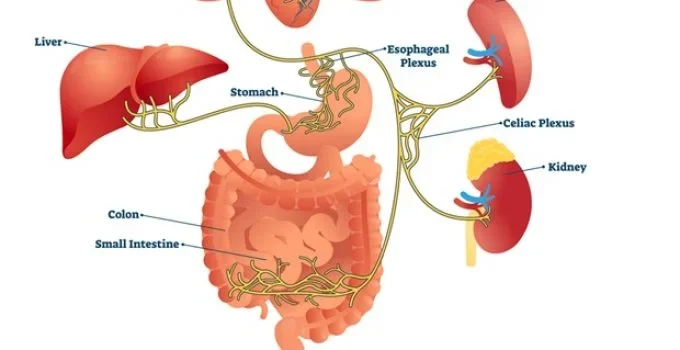How Does the Stomach Connect to Other Organs?
The stomach connects to several key digestive and supportive organs through muscular valves, ducts, blood vessels, and structural membranes. It links upward to the esophagus and downward to the duodenum, the first part of the small intestine. Beyond this, the stomach has important anatomical relationships with the pancreas, liver, spleen, and omentum, which help integrate it into the broader gastrointestinal system. These connections allow it to serve as both a receiver and dispatcher of food, enzymes, blood flow, and nutrients.
Dive Deeper
- Stomach’s Placement in the Body
- Upper Connection: The Esophagus
- Lower Connection: The Duodenum
- Supportive Organs and Structures
- Ligaments and the Omentum
- Stomach Blood Supply and Drainage
- 🗺️ Connection Overview Table
- 🎯 Final Thoughts
- 📚 References
Stomach’s Placement in the Body
Anatomically, the stomach sits in the upper left quadrant of the abdomen, partially protected by the ribcage. It lies just below the diaphragm and is surrounded by various organs:
- Anteriorly: The liver (right side) and anterior abdominal wall
- Posteriorly: The pancreas and spleen
- Inferiorly: The transverse colon
- Superiorly: The diaphragm and heart (indirectly through the diaphragm)
This central positioning supports its role in digestion and its connections to nearby organs.
Upper Connection: The Esophagus
At its upper end, the stomach connects to the esophagus via the cardiac or lower esophageal sphincter (LES). This muscular valve:
- Prevents acid reflux by keeping stomach contents from moving backward
- Allows food entry from the esophagus during swallowing
🔍 Fact: The LES is not a true sphincter in anatomical terms but functions as one through muscular tone and surrounding structures [1].
Lower Connection: The Duodenum
The pyloric sphincter marks the stomach’s lower outlet, leading into the duodenum, the first part of the small intestine. This connection is vital for:
- Regulating chyme release from the stomach
- Initiating further digestion via enzymes from the pancreas and bile from the liver
The duodenum curves around the head of the pancreas, forming a tight anatomical and functional loop between the three.
Supportive Organs and Structures
Liver
- Although not directly connected to the stomach, the liver sits close to its upper right side.
- It secretes bile, which travels via the common bile duct into the duodenum to aid in fat digestion.
Pancreas
- Positioned posterior to the stomach.
- Secretes digestive enzymes into the duodenum via the pancreatic duct.
Spleen
- Located to the left and slightly behind the stomach.
- Connected via the gastrosplenic ligament and involved in immune and blood-filtering functions.
📊 The pancreas and liver together contribute to over 90% of digestive enzyme activity in the small intestine [2].
Ligaments and the Omentum
Several peritoneal ligaments and folds help tether the stomach to nearby organs and support its structure:
| Structure | Connected Organs |
|---|---|
| Lesser omentum | Stomach to liver |
| Greater omentum | Stomach to transverse colon |
| Gastrosplenic ligament | Stomach to spleen |
| Gastrophrenic ligament | Stomach to diaphragm |
The omentum (especially the greater omentum) serves as a fat-storing, immune-responding “apron” hanging from the stomach.
Stomach Blood Supply and Drainage
The stomach is highly vascularized, ensuring rapid digestion and transport of nutrients.
Arterial Supply
- Supplied by branches of the celiac trunk, including:
- Left gastric artery
- Right gastric artery
- Right and left gastroepiploic arteries
- Short gastric arteries
Venous Drainage
- Blood from the stomach drains into the portal vein, traveling to the liver for nutrient processing and detoxification.
🗺️ Connection Overview Table
| Connected Organ | Structure Involved | Function |
|---|---|---|
| Esophagus | Lower esophageal sphincter | Food entry; prevents reflux |
| Duodenum | Pyloric sphincter | Controls chyme release |
| Liver | Lesser omentum, bile duct (indirect) | Bile production; indirect digestive aid |
| Pancreas | No direct link; adjacent to stomach | Enzyme secretion into duodenum |
| Spleen | Gastrosplenic ligament | Immune function; no role in digestion |
| Colon | Greater omentum | Structural support; digestive continuation |
🎯 Final Thoughts
The stomach isn’t an isolated chamber—it is an integrated nexus in the digestive system. Through a combination of muscular openings, shared membranes, and blood vessels, it connects to organs that assist in food breakdown, nutrient processing, and immune support. These anatomical ties highlight the stomach’s central position in a highly coordinated digestive network, where every connection ensures the proper flow of food, fluids, and information.
📚 References
- Tortora, G.J., & Derrickson, B. (2017). Principles of Anatomy and Physiology. Wiley.
- Guyton, A.C., & Hall, J.E. (2016). Textbook of Medical Physiology (13th ed.). Elsevier.
- Drake, R., Vogl, A.W., & Mitchell, A.W.M. (2020). Gray’s Anatomy for Students (4th ed.). Elsevier.
- National Institute of Diabetes and Digestive and Kidney Diseases. “Your Digestive System & How It Works.” https://www.niddk.nih.gov
